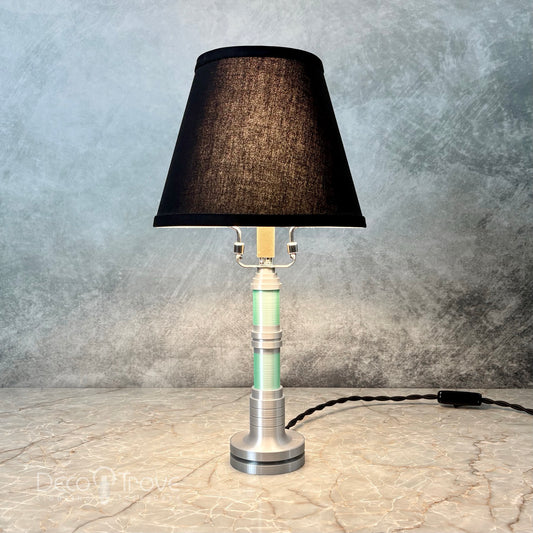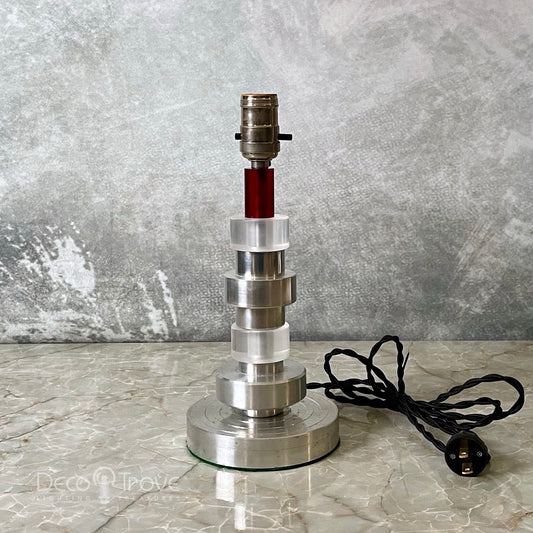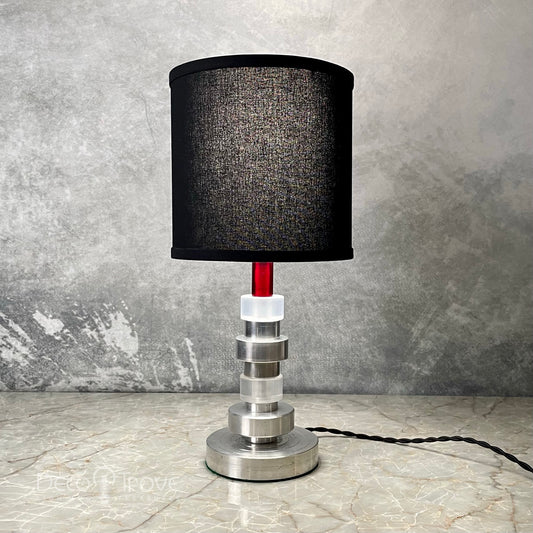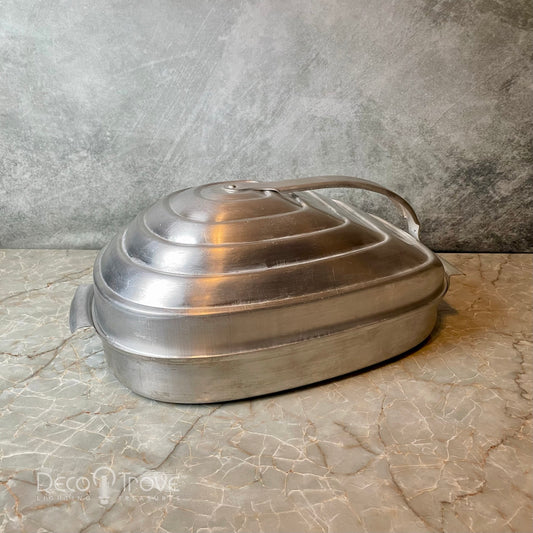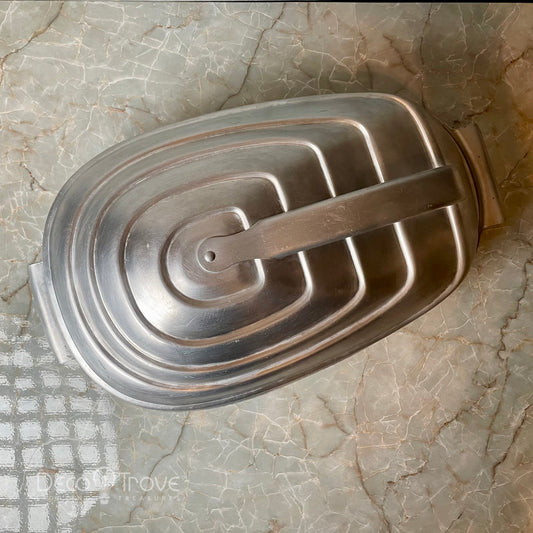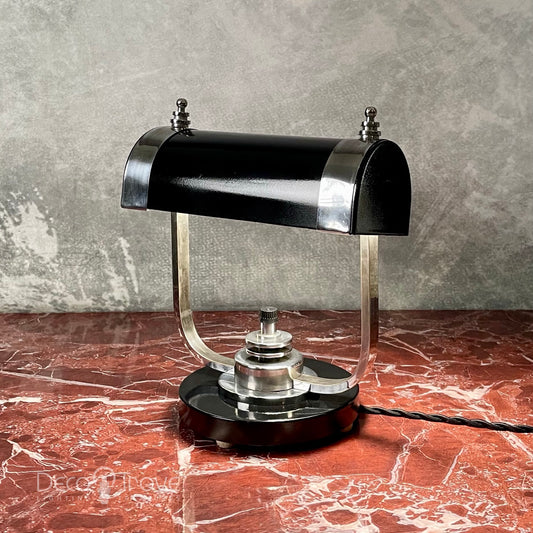Elements of Streamline Design: Speed Rings
Cuota
Speed Rings
Speed rings, also called "discs" or "fins", are one of the most iconic elements of streamline art deco design; so iconic that they were used in designs and media spanning several decades including many 1930s - 1950s sci-fi serials and films. During the streamlining of the 1930s you could find many different household products such as lighting, furniture, cups, and dinner bells adorned with them. Speed rings are radiator-like design elements, often appearing in pairs, that have the effect of making an object look more mechanistic and futuristic. They also emphasize visual movement through their horizontal line (when viewed directly) and circular shape (when viewed from above). Speed rings were a definitive nod to "the machine age" and a notable visual shift from the zigzag and chevrons that were so popular in 1920's art deco design.
One of the earliest renderings of the speed ring design element can be found within the 1927 German film "Metropolis." During this scene the character Maria has her likeness transferred to the Maschinenmensch (robot) and as this transformation takes place we see three sets of concentric rings rapidly moving up and down which magically reveal the metamorphosis that has taken place.
 Fig 1. Metropolis, Maria's Transformation - (1927).
Fig 1. Metropolis, Maria's Transformation - (1927).
While It's not known exactly where the speed ring design element came from it's likely that it was due to a combination of factors ranging from popular media of the time and a fascination with technology, speed, and aerodynamics. Machine parts such as radiators, grills, and gears are all thought to be possible influences on the design element. It's also speculated by some that the speed ring was inspired from the horizontal lines found in the (Fig 2) structure of biplane airplane wings - or possibly the propellor blade.
 Fig 2. Boeing B40 Biplane, Possible inspiration for Speed Rings. Photo by Bill Larkins. WikiCommons.
Fig 2. Boeing B40 Biplane, Possible inspiration for Speed Rings. Photo by Bill Larkins. WikiCommons.
Additionally speed rings were likely influenced by the exploding electrification of society and the growing importance of electrified consumer goods in everyday life for many Americans. (Fig 3) showcases a set of large 1920s GE ceramic insulators being prepped for use in large overhead power lines. The disc shape on the insulators serves to help keep moisture out from the wire connections and prevent arcing.

Fig 3. Ceramic Electrical Insulators, GE Promotional Film (1920s).
In the world of designed objects, one of the earliest examples of speed rings appeared on a cocktail cup designed in the late 1920s, much earlier than most might expect this element to appear. Below (Fig 4) is a cocktail cup in copper with brass speed rings with a cobalt blue glass insert. It is often attributed to Walter von Nessen and was created in 1928.
 Fig 4. Cocktail Cup, Walter von Nessen - attributed (c1928) - Nessen Studios. Photo from collection of Author.
Fig 4. Cocktail Cup, Walter von Nessen - attributed (c1928) - Nessen Studios. Photo from collection of Author.
The following is a skyscraper style night table designed by KEM Weber (Fig 5), which is flanked on each side with a tall tubular glass accent lamp which features a finial made up of speed rings and a spherical knob top. This night table represents a rare object that combines both the older art deco (zig zag moderne) and the emerging streamline aesthetic.
 Fig 5. Night Table, KEM Weber - (c1928) - Minneapolis Institute of Art.
Fig 5. Night Table, KEM Weber - (c1928) - Minneapolis Institute of Art.
A shining beauty (Fig 6) is an innovative chrome-plated torchiere that utilized inverted funnels to distribute light indirectly across the sides of the shade and directly from the top like a traditional torchiere. The top and bottom of the fluted column is flanked with speed rings.
As the streamline style began to work its way into the modern home in the early 1930s, many designers experimented with utilizing the speed ring form for more than just ornamentation. The glass desk lamp below (Fig 7a) from Nessen Studio was featured in a 1930 issue of House Beautiful. This was an important experiment in light diffusion that would later go on to inspire several other lighting designs, including one extraordinary design that today appears in many modern design collections (Fig 7b).
 Fig 7a. 1930 House Beautiful (1930-08 Vol 68 Issue 2), Desk Lamp - Nessen Studio - (c1930).
Fig 7a. 1930 House Beautiful (1930-08 Vol 68 Issue 2), Desk Lamp - Nessen Studio - (c1930).
Featured below, (Fig 7b) is a streamline lamp from Pattyn Products of Detroit made circa 1946. The designer is unknown but has been attributed to Walter Von Nessen. The body is made of a single piece of machined aluminum inset with bands of red and black bakelite and brass. Note the functional use of the 6 speed rings to form the structure of the lamp shade. The speed rings serve to further direct and diffuse the light from the inner frosted glass shade just like the example above.
 Fig 7b. Piston Lamp - model 310, Designer Unknown (c1946) - Pattyn Products. Photo from collection of Author.
Fig 7b. Piston Lamp - model 310, Designer Unknown (c1946) - Pattyn Products. Photo from collection of Author.
Other designers in the early 1930's experimented with louvered shades and lamps with much different shapes as shown in (Fig 7c) a patent design for a table lamp by Leroy C. Doane for the Miller Co.
 Fig 7c. Table Lamp Patent Illustration, Leroy Doane - (1932) - Miller Co.
Fig 7c. Table Lamp Patent Illustration, Leroy Doane - (1932) - Miller Co.
Following the stock market crash in 1929, in the depths of the Great Depression, The 1933 World's Fair (Fig 8) brought the promise of a better tomorrow into the public consciousness through modernity and futurism. With a tagline of "A Century of Progress" the event introduced the latest in modern technology available to the public through a myriad of consumer products. The fair represented a major turning point in American design as the "modern" style shifted from what we would call Art Deco to Streamline Moderne. One very notable motif featured in not only fair graphics, but also products, was the illustrious planet Saturn with its iconic concentric rings.

Fig 8. 1933 World's Fair Poster, features Saturn with spiraled rings - (1933).
This diminutive and stylish dinner bell (Fig 9) was created in 1935 by Ruth Gerth working for Chase Brass and Copper Co. It features a very simple modern design flanked by 2 speed rings and a colored catalin knob on the top.
 Fig 9. Dinner Bell, Ruth Gerth - attributed (c1935) - Chase Brass & Copper Co. Photo from collection of Author.
Fig 9. Dinner Bell, Ruth Gerth - attributed (c1935) - Chase Brass & Copper Co. Photo from collection of Author.
The popularity of comics like Buck Rogers in the mid 1930's spurred the development of several toy "ray guns" based upon the series (Fig 10) XZ-38 Disintegrator Pistol.
This lamp (Fig 12) really epitomizes the best of streamline deco. A beautiful column of swirled green and yellow catalin (a new material in the 1930s) is offset with 3 tiered sets of aluminum speed rings. The rings are arranged so that they get larger as they get closer to the base and just seem to disappear into the design. It's almost like the streamlined version of a skyscraper form that would have been popular during the art deco (zig zag moderne) of the 1920s.

Fig 12. Catalin Streamlined Lamp - Unknown Designer (c1937) - Unknown Manufacturer. Photo from collection of Author.
Speed rings also appeared in popular sci-fi serials of the era like the highly regarded American serial Flash Gordon, 1936 (Fig 13) and Buck Rogers, 1939 (Fig 14). The crew is aboard a rocket here next to a part of machinery that appears to have speed rings or a type of streamlined disc as an integral component. (Fig 14) & (Fig 15) Depict futuristic weapons that also utilize speed rings on the end of the barrel.

Fig 13. Flash Gordon, Rocket Interior - (1936).

Fig 14. Flash Gordon, Weapon - (1936).

Fig 15. Buck Rogers, Weapon - (1939).

 Fig 6.
Fig 6. 

